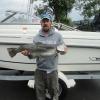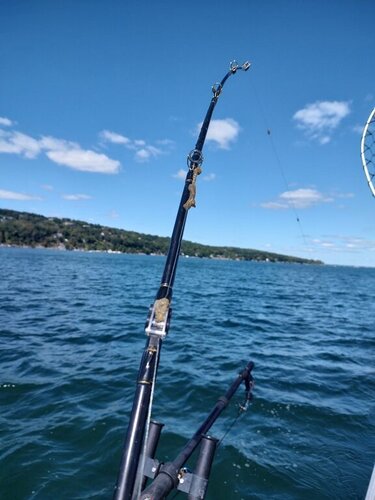-
Posts
13,835 -
Joined
-
Last visited
Content Type
Profiles
Forums
Events
Gallery
Store
Posts posted by Sk8man
-
-
A lot of companies use the same blank manufacturer and some have their name stamped on them but blanks tend to be the same dimensions and component materials.
-
Cool Mike. I used to get a lot of those Sheepshead at Mays Point in the old days on those spinning rods with 6 lb test seemed like forever getting them in

-
Really healthy looking fish.....great to see they are doing so well there.
-
Decided to go solo about 8am after rainbows. launched at north end and set up near the pump station on west side. It was pretty breezy so I decided to run just two five leader Seth Green rigs to try out some small Elmer Hinckley spoons I recently received instead of the usual three rigs..
Trolled to just south of Menteth Point and had first hit and run that took out drag but gone when I got to the rod. Checked temps with the X4D. 71.8 surface and 54 degrees at 62 feet. I had set up both rods with the new #87 spoons in gold, hammered gold, hammered silver and plain silver. I was trolling in 200-220 ft of water and varying speeds but 1.9-2.1 at ball seemed best for these particular spoons. I started getting hammered by 2-3 lb bows and went 9 for 12 on them (all released unharmed). No real big ones but it was a lot of fun with the jumpers etc. Very strong year class apparently and good sized school of them there. I worked it until about 2PM when the wind started making things less fun. The fleas were horrible even some on the probe rigger wire. and they were the fishhook variety so not easy to get off either. Saw a few other boats working the general area but didn't see whether they did anything.
-
 7
7
-
-
Nice looking rig John. Best of luck with the coaching!

-
Usually I use size 1/0 for small spoons, 2/0 for mediums, and 2 or 3/0 for magnum sized spoons. Sometimes there are differences between manufacturers on hook sizes though so these refer to the Mustads By the way the hooks I use are open ended so it is just a matter of clenching carefully with pliers to attach them. With Suttons I cut the treble right off and replace on the existing solid ring.
-
 2
2
-
-
-
Ditto on being much easier to release fish with singles (just grab shaft of hook with needle nose pliers and a twist of the wrist while fish still in the water) and fewer problems (perhaps none) getting tangled in the net.
-
 1
1
-
 2
2
-
-
Yes yes and Yes
 I switched most of my spoons to Mustad 9510 xxx stainless siwash singles about 30 years ago, continue to do so, and never looked back. I know everyone here has their own personal preferences but what I found early on is that with trebles the fish (especially large fish with the weaker type trebles) can work the trebles out of their mouths by pressing down on the two disengaged hooks freeing the third engaged hook and getting free. I seldom (almost never) lose fish on spoons with these singles. I leave stick baits alone as the balance can be touchy. The trouble now is that Mustad seems to have stopped making those particular hooks and now seems to be concentrating on the larger salt water hooks. There are other very good single hooks on the market but the points tend to be shorter in length so I still prefer the Mustads. Luckily, I switched over over the years with well over a thousand spoons so I'm still in good shape
I switched most of my spoons to Mustad 9510 xxx stainless siwash singles about 30 years ago, continue to do so, and never looked back. I know everyone here has their own personal preferences but what I found early on is that with trebles the fish (especially large fish with the weaker type trebles) can work the trebles out of their mouths by pressing down on the two disengaged hooks freeing the third engaged hook and getting free. I seldom (almost never) lose fish on spoons with these singles. I leave stick baits alone as the balance can be touchy. The trouble now is that Mustad seems to have stopped making those particular hooks and now seems to be concentrating on the larger salt water hooks. There are other very good single hooks on the market but the points tend to be shorter in length so I still prefer the Mustads. Luckily, I switched over over the years with well over a thousand spoons so I'm still in good shape (Owner, Gamakatsu, and VMC also make quality hooks)
(Owner, Gamakatsu, and VMC also make quality hooks)
-
 2
2
-
-
Ditto Anthony. You have come a long way in your fishing in a relatively short time

-
 1
1
-
-
Best of luck with it Rick! Going to be fun to rig

-
 1
1
-
-
 Some great eaters right there
Some great eaters right there
-
-
-
Think I'm going to hold on to it for now thanks.
-
troutman 10 you have a PM
-
It has been really taken care of despite seeing a lot of night time trout and bullheads
 It helped to have been in the case since new.
It helped to have been in the case since new.
-
-
I know this sounds strange but carefully check the "pee hole" very often spiders get in there and block it up believe it or not.
-
 1
1
-
-
Thanks salmoseine

-
I didn't realize there was going to be one. Could you Pm me the details? Thx
-
Hoping to go next week but it is insane going there on Labor Day weekend. Trailers will be all the way out to the road today and tomorrow and south end will be busy as well
-
Regardless of luck you guys seem to be having a blast Clark

-
Nice going Brian. Beautiful day......but stuck with yard work





Canandaigua 9-16-23
in Finger Lakes Discussion
Posted
Well I was solo remember....I did start taking pics with my phone and almost dropped it in the water and that ended that. The ones I took weren't great either but i'll post the ones I took. All fish were released in the water by the way. These are the least blurry